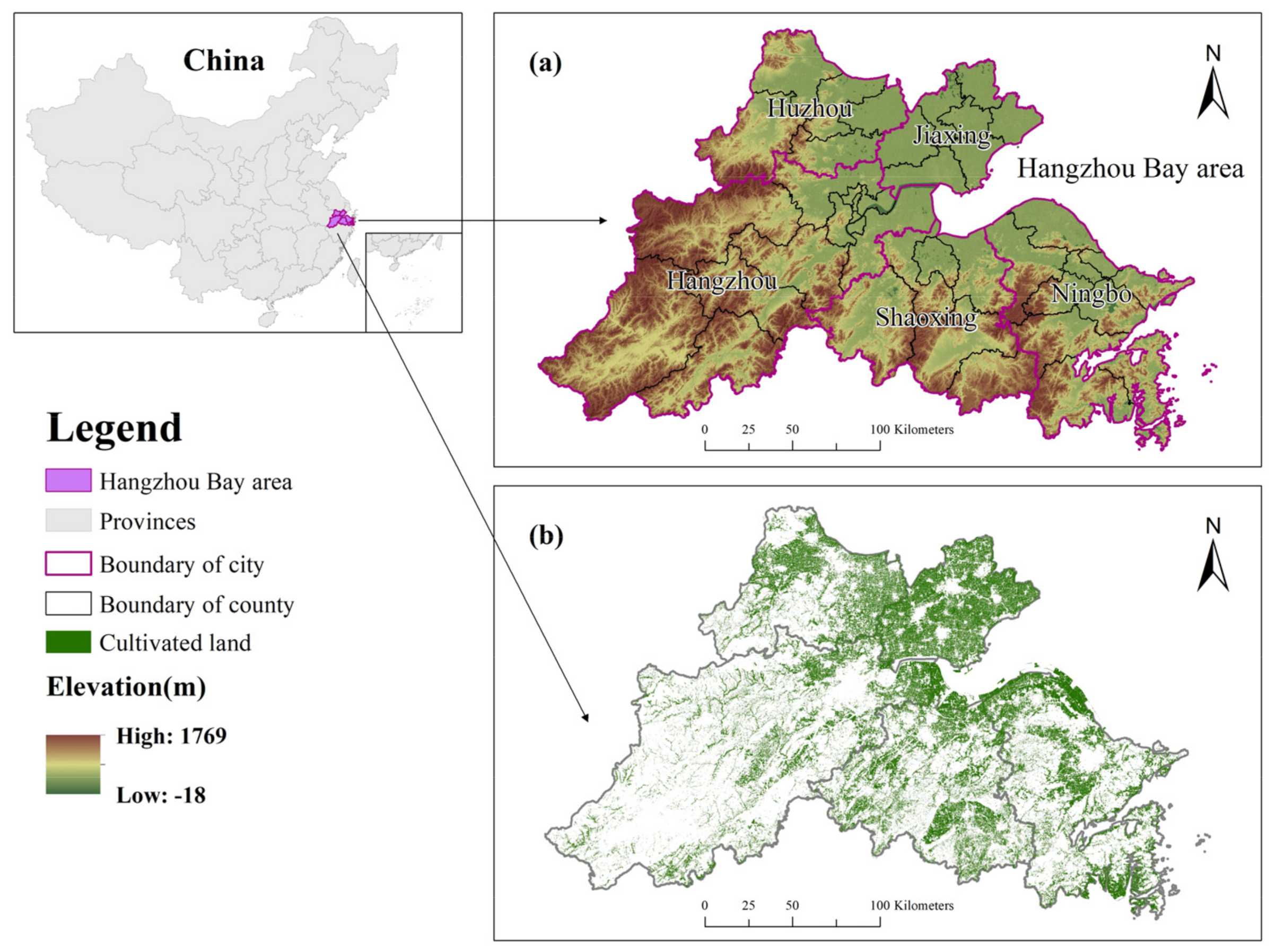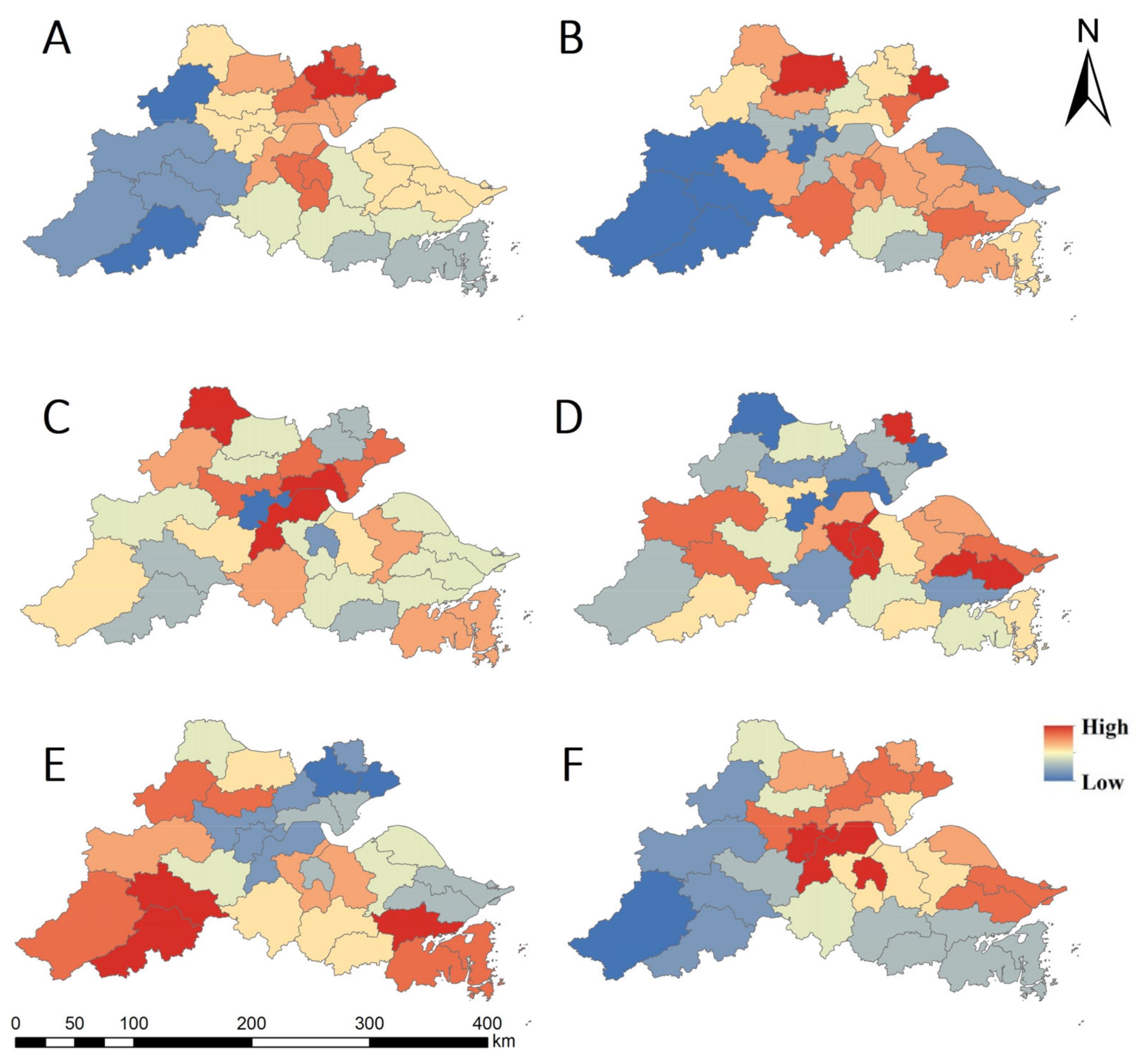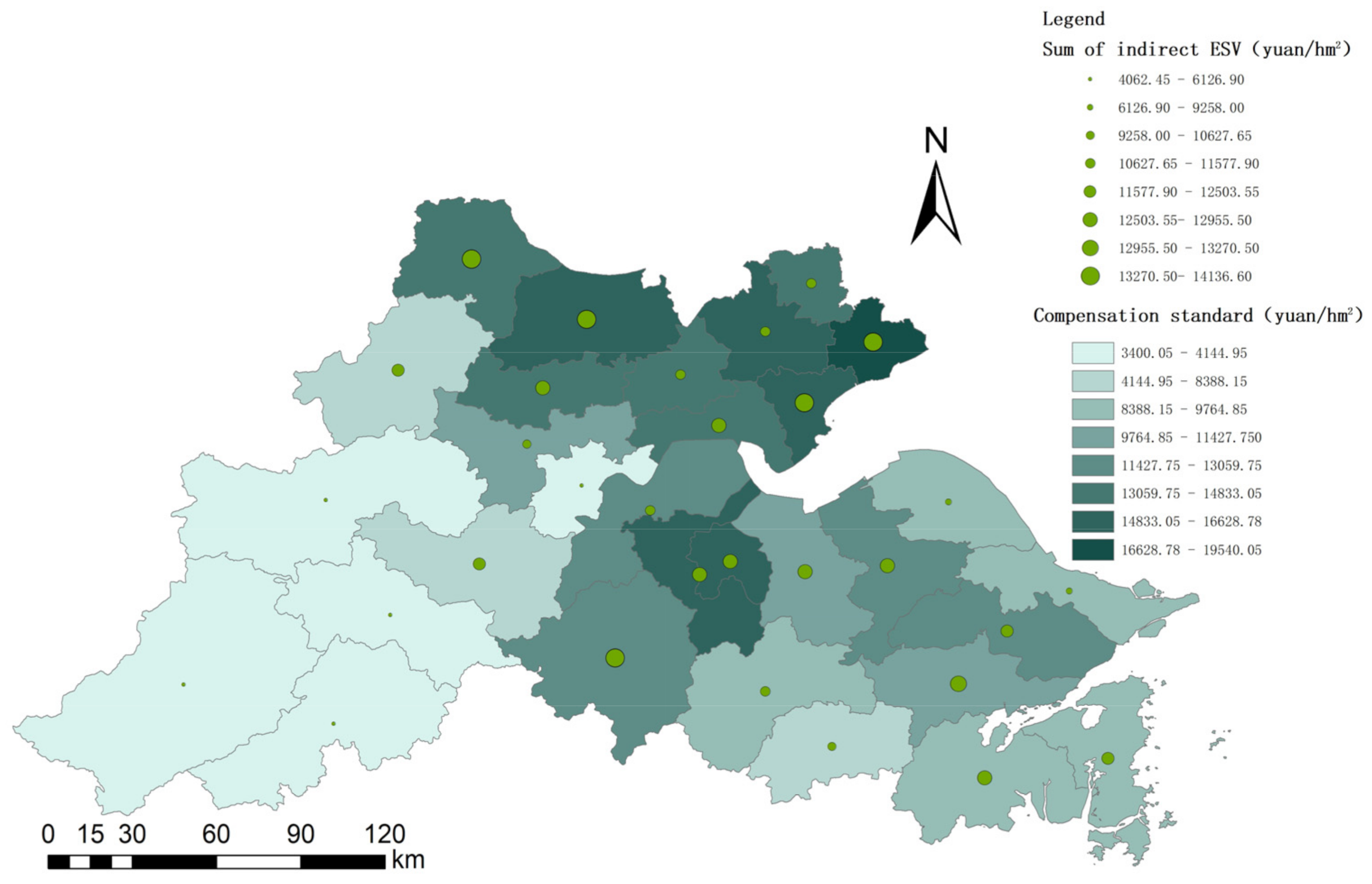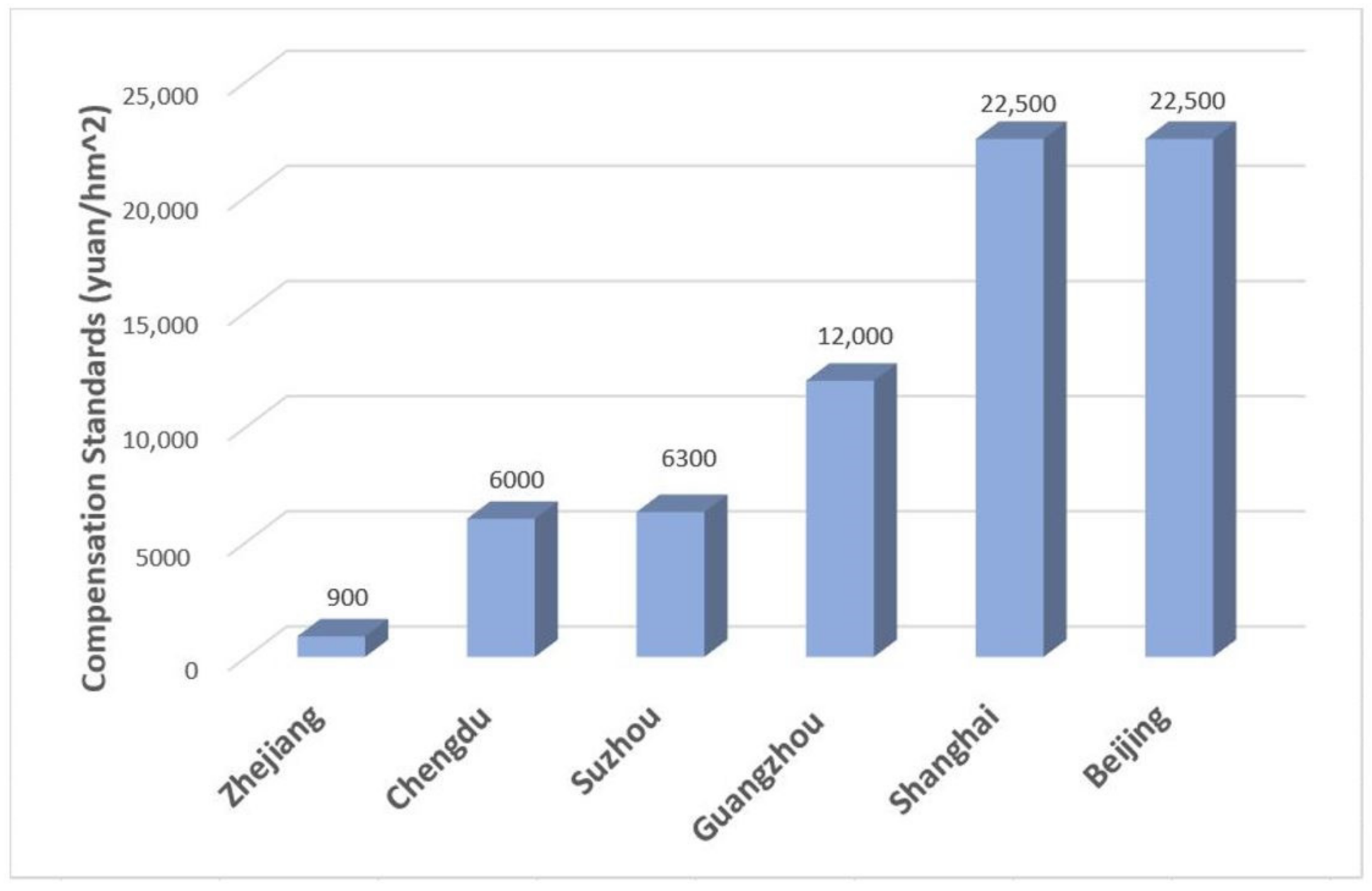Optimizing the Compensation Standard of Cultivated Land Protection Based on Ecosystem Services in the Hangzhou Bay Area, China
Abstract
:1. Introduction
2. Materials and Methods
2.1. Study Area
2.2. Data Collection
2.3. Classification of Cultivated Land Ecosystem Service
2.4. Assessment of Cultivated Land Ecosystem Services
2.4.1. Food Production
2.4.2. Carbon Sequestration and Oxygen Production
2.4.3. Water Conservation
2.4.4. Soil Conservation
2.4.5. Biodiversity Maintenance
2.4.6. Cultural Leisure
2.5. Calculation of Compensation Standards for Cultivated Land Protection
3. Results
3.1. Evaluation of Ecosystem Services
3.2. Compensation Standard for Cultivated Land Protection
4. Discussion
4.1. The Rationality and Reality of Compensation Standard
4.2. Insights for Cultivated Land Protection Policy
4.3. Limitation and Further Improvement
5. Conclusions
Author Contributions
Funding
Institutional Review Board Statement
Informed Consent Statement
Data Availability Statement
Acknowledgments
Conflicts of Interest
References
- Ma, A.; Zhang, J. The Use of Choice Experiments to Value Public Preferences for Cultivated Land Protection in China. J. Resour. Ecol. 2014, 5, 263–271. [Google Scholar]
- Lu, X.; Qu, Y.; Sun, P.; Yu, W.; Peng, W. Green Transition of Cultivated Land Use in the Yellow River Basin: A Perspective of Green Utilization Efficiency Evaluation. Land 2020, 9, 475. [Google Scholar] [CrossRef]
- Su, M.; Guo, R.; Hong, W. Institutional transition and implementation path for cultivated land protection in highly urbanized regions: A case study of Shenzhen, China. Land Use Policy 2019, 81, 493–501. [Google Scholar] [CrossRef]
- Xie, H.; Zhang, Y.; Choi, Y. Measuring the Cultivated Land Use Efficiency of the Main Grain-Producing Areas in China under the Constraints of Carbon Emissions and Agricultural Nonpoint Source Pollution. Sustainability 2018, 10, 1932. [Google Scholar] [CrossRef] [Green Version]
- Zhao, J.; Luo, Q.; Deng, H.; Yan, Y. Opportunities and challenges of sustainable agricultural development in China. Philos. Trans. R. Soc. Lond. Ser. B Biol. Sci. 2008, 363, 893–904. [Google Scholar] [CrossRef] [Green Version]
- Sun, M.; Huo, Z.; Zheng, Y.; Dai, X.; Feng, S.; Mao, X. Quantifying long-term responses of crop yield and nitrate leaching in an intensive farmland using agro-eco-environmental model. Sci. Total Environ. 2018, 613–614, 1003–1012. [Google Scholar] [CrossRef]
- Hua, X.; Yan, J.; Li, H.; He, W.; Li, X. Wildlife damage and cultivated land abandonment: Findings from the mountainous areas of Chongqing, China. Crop. Prot. 2016, 84, 141–149. [Google Scholar] [CrossRef]
- Wu, Y.; Shan, L.; Guo, Z.; Peng, Y. Cultivated land protection policies in China facing 2030: Dynamic balance system versus basic farmland zoning. Habitat Int. 2017, 69, 126–138. [Google Scholar] [CrossRef]
- Palm, C.; Blanco-Canqui, H.; DeClerck, F.; Gatere, L.; Grace, P. Conservation agriculture and ecosystem services: An overview. Agric. Ecosyst. Environ. 2014, 187, 87–105. [Google Scholar] [CrossRef] [Green Version]
- Fagerholm, N.; Torralba, M.; Moreno, G.; Girardello, M.; Herzog, F.; Aviron, S.; Burgess, P.; Crous-Duran, J.; Ferreiro-Domínguez, N.; Graves, A.; et al. Cross-site analysis of perceived ecosystem service benefits in multifunctional landscapes. Glob. Environ. Chang. 2019, 56, 134–147. [Google Scholar] [CrossRef] [Green Version]
- Doxa, A.; Paracchini, M.L.; Pointereau, P.; Devictor, V.; Jiguet, F. Preventing biotic homogenization of farmland bird communities: The role of High Nature Value farmland. Agric. Ecosyst. Environ. 2012, 148, 83–88. [Google Scholar] [CrossRef]
- Carpenter, S.R.; DeFries, R.; Dietz, T.; Mooney, H.A.; Polasky, S.; Reid, W.V.; Scholes, R.J. Millennium Ecosystem Assessment: Research needs. Science 2006, 314, 257–258. [Google Scholar] [CrossRef]
- Zhang, W.; Ricketts, T.H.; Kremen, C.; Carney, K.; Swinton, S.M. Ecosystem services and dis-services to agriculture. Ecol. Econ. 2007, 64, 253–260. [Google Scholar] [CrossRef] [Green Version]
- Cao, Y.; Cao, Y.; Li, G.; Tian, Y.; Fang, X.; Li, Y.; Tan, Y. Linking ecosystem services trade-offs, bundles and hotspot identification with cropland management in the coastal Hangzhou Bay area of China. Land Use Policy 2020, 97, 104689. [Google Scholar] [CrossRef]
- Ou, M.; Wang, K.; Guo, J. Research progress on ecological compensation mechanism of farmland protection. Res. Agric. Mod. 2019, 40, 357–365. [Google Scholar]
- Yu, D.; Wang, D.; Li, W.; Liu, S.; Zhu, Y.; Wu, W.; Zhou, Y. Decreased Landscape Ecological Security of Peri-Urban Cultivated Land Following Rapid Urbanization: An Impediment to Sustainable Agriculture. Sustainability 2018, 10, 394. [Google Scholar] [CrossRef] [Green Version]
- Wang, K.; Ou, M.; Wolde, Z. Regional Differences in Ecological Compensation for Cultivated Land Protection: An Analysis of Chengdu, Sichuan Province, China. Int. J. Environ. Res. Public Health 2020, 17, 8242. [Google Scholar] [CrossRef]
- Zhang, Z.; Wen, Q.; Liu, F.; Zhao, X.; Liu, B.; Xu, J.; Yi, L.; Hu, S.; Wang, X.; Zuo, L.; et al. Urban expansion in China and its effect on cultivated land before and after initiating “Reform and Open Policy”. Sci. China (Earth Sci). 2016, 59, 1930–1945. [Google Scholar] [CrossRef]
- Xu, D.; Deng, X.; Guo, S.; Liu, S. Labor migration and farmland abandonment in rural China: Empirical results and policy implications. J. Environ. Manag. 2019, 232, 738–750. [Google Scholar] [CrossRef]
- Huang, J.; Wang, X.; Zhi, H.; Huang, Z.; Rozelle, S. Subsidies and distortions in China’s agriculture: Evidence from producer-level data. Aust. J. Agric. Resour. Econ. 2011, 55, 53–71. [Google Scholar] [CrossRef] [Green Version]
- Wang, G.; Liu, Y.; Li, Y.; Chen, Y. Dynamic trends and driving forces of land use intensification of cultivated land in China. J. Geogr. Sci. 2015, 25, 45–57. [Google Scholar] [CrossRef] [Green Version]
- Bai, Y.; Liu, M.; Yang, L. Calculation of Ecological Compensation Standards for Arable Land Based on the Value Flow of Support Services. Land 2021, 10, 719. [Google Scholar] [CrossRef]
- Zhang, S.; Hu, W.; Li, M.; Guo, Z.; Wang, L.; Wu, L. Multiscale research on spatial supply-demand mismatches and synergic strategies of multifunctional cultivated land. J. Environ. Manag. 2021, 299, 113605. [Google Scholar] [CrossRef] [PubMed]
- Liu, X.; Zhao, C.; Song, W. Review of the evolution of cultivated land protection policies in the period following China’s reform and liberalization. Land Use Policy 2017, 67, 660–669. [Google Scholar] [CrossRef]
- Claassen, R.; Cattaneo, A.; Johansson, R. Cost-effective design of agri-environmental payment programs: U.S. experience in theory and practice. Ecol. Econ. 2008, 65, 737–752. [Google Scholar] [CrossRef]
- Tan, R.; Wang, R.; Sedlin, T. Land-Development Offset Policies in the Quest for Sustainability: What Can China Learn from Germany? Sustainability 2014, 6, 3400–3430. [Google Scholar] [CrossRef] [Green Version]
- Baylis, K.; Peplow, S.; Rausser, G.; Simon, L. Agri-environmental policies in the EU and United States: A comparison. Ecol. Econ. 2008, 65, 753–764. [Google Scholar] [CrossRef]
- Ma, S.; Swinton, S.M.; Lupi, F.; Jolejole-Foreman, C. Farmers’ Willingness to Participate in Payment-for-Environmental-Services Programmes. J. Agric. Econ. 2012, 63, 604–626. [Google Scholar] [CrossRef]
- Gardner, B.D. The Economics of Agricultural Land Preservation. Am. J. Agric. Econ. 1977, 59, 1027–1036. [Google Scholar] [CrossRef]
- Corbelle-Rico, E.; Sánchez-Fernández, P.; López-Iglesias, E.; Lago-Peñas, S.; Da-Rocha, J. Putting land to work: An evaluation of the economic effects of recultivating abandoned farmland. Land Use Policy 2022, 112, 105808. [Google Scholar] [CrossRef]
- Zhang, S.; Hu, W.; Zhang, J.; Li, M.; Zhu, Q. Mismatches in Suppliers’ and Demanders’ Cognition, Willingness and Behavior with Respect to Ecological Protection of Cultivated Land: Evidence from Caidian District, Wuhan, China. Int. J. Environ. Res. Public Health 2020, 17, 1156. [Google Scholar] [CrossRef] [Green Version]
- Wang, N.; Zu, J.; Li, M.; Zhang, J.; Hao, J. Spatial Zoning of Cultivated Land in Shandong Province Based on the Trinity of Quantity, Quality and Ecology. Sustainability 2020, 12, 1849. [Google Scholar] [CrossRef] [Green Version]
- Fischer, G.; Prieler, S.; van Velthuizen, H.; Lensink, S.M.; Londo, M.; de Wit, M. Biofuel production potentials in Europe: Sustainable use of cultivated land and pastures. Part I: Land productivity potentials. Biomass Bioenergy 2010, 34, 159–172. [Google Scholar] [CrossRef] [Green Version]
- Wade, M.R.; Gurr, G.M.; Wratten, S.D. Ecological restoration of farmland: Progress and prospects. Philos. Trans. R. Soc. Lond. Ser. B Biol. Sci. 2008, 363, 831–847. [Google Scholar] [CrossRef] [Green Version]
- Costanza, R.; D’Arge, R.; de Groot, R.; Farber, S.; Grasso, M.; Hannon, B.; Limburg, K.; Naeem, S.; O’Neill, R.V.; Paruelo, J.; et al. The value of the world’s ecosystem services and natural capital. Ecol. Econ. 1998, 25, 3–15. [Google Scholar] [CrossRef]
- Xie, G.; Lu, C.; Leng, Y.; Zheng, D.; Li, S. The Value Evaluation of Ecological Assets on the Qinghai-Tibet Plateau. J. Nat. Resour. 2003, 2, 189–196. [Google Scholar]
- Xie, G.; Zhang, C.; Zhang, L.; Chen, W.; Li, S. Improvement of the Evaluation Method for Ecosystem Service Value Based on Per Unit Area. J. Nat. Resour. 2015, 30, 1243–1254. [Google Scholar]
- Xie, H.; Huang, Y.; Choi, Y.; Shi, J. Evaluating the sustainable intensification of cultivated land use based on emergy analysis. Technol. Forecast. Soc. 2021, 165, 120449. [Google Scholar] [CrossRef]
- Moreno-Sanchez, R.; Maldonado, J.H.; Wunder, S.; Borda-Almanza, C. Heterogeneous users and willingness to pay in an ongoing payment for watershed protection initiative in the Colombian Andes. Ecol. Econ. 2012, 75, 126–134. [Google Scholar] [CrossRef]
- Xiong, K.; Kong, F. The Analysis of Farmers’ Willingness to Accept and Its Influencing Factors for Ecological Compensation of Poyang Lake Wetland. Procedia Eng. 2017, 174, 835–842. [Google Scholar] [CrossRef]
- Costanza, R.; de Groot, R.; Braat, L.; Kubiszewski, I.; Fioramonti, L.; Sutton, P.; Farber, S.; Grasso, M. Twenty years of ecosystem services: How far have we come and how far do we still need to go? Ecosyst. Serv. 2017, 28, 1–16. [Google Scholar] [CrossRef]
- Zang, Z.; Zou, X.; Zuo, P.; Song, Q.; Wang, C.; Wang, J. Impact of landscape patterns on ecological vulnerability and ecosystem service values: An empirical analysis of Yancheng Nature Reserve in China. Ecol. Indic. 2017, 72, 142–152. [Google Scholar]
- Jiang, C.H.; Li, G.Y.; Li, H.Q.; Li, M. The Study of Ecological Service Value of Farmland Ecosystem in the Beijing-Tianjin-Hebei Region. IOP conference series. Earth Environ. Sci. 2017, 86, 12004. [Google Scholar]
- Shi, Y.; Duan, W.; Fleskens, L.; Li, M.; Hao, J. Study on evaluation of regional cultivated land quality based on resource-asset-capital attributes and its spatial mechanism. Appl. Geogr. 2020, 125, 102284. [Google Scholar] [CrossRef]
- Buyanovsky, G.A.; Wagner, G.H. Carbon cycling in cultivated land and its global significance. Global Chang. Biol. 1998, 4, 131–141. [Google Scholar] [CrossRef]
- Chen, L.; Hao, J.; Wang, F.; Yin, Y.; Gao, Y.; Duan, W.; Yang, J. Carbon sequestration function of cultivated land use system based on the carbon cycle for the Huang-Huai-Hai Plain. Resour. Sci. 2016, 38, 1039–1053. [Google Scholar]
- Wang, J.; Cao, Y.; Fang, X.; Li, G.; Cao, Y. Identification of the trade-offs/synergies between rural landscape services in a spatially explicit way for sustainable rural development. J. Environ. Manag. 2021, 300, 113706. [Google Scholar] [CrossRef]
- Zhang, F.; Wu, P.; Zhao, X.; Zhang, E.; Cheng, X.F. Effects of conservation tillage on soil water regimes and water use efficiency in farmland of Heihe River Basin in Northwest China. Afr. J. Agric. Res. 2011, 6, 5959–5966. [Google Scholar]
- Song, W.; Deng, X. Effects of Urbanization-Induced Cultivated Land Loss on Ecosystem Services in the North China Plain. Energies 2015, 8, 5678–5693. [Google Scholar] [CrossRef]
- Ma, B.; Ma, F.; Li, Z.; Wu, F. Effect of crops on rainfall redistribution processes under simulated rainfall. Trans. Chin. Soc. Agric. Eng. 2014, 30, 136–146. [Google Scholar]
- Mamedov, A.I.; Levy, G.J. Soil erosion–runoff relations on cultivated land: Insights from laboratory studies. Eur. J. Soil Sci. 2019, 70, 686–696. [Google Scholar] [CrossRef]
- Sun, X.; Xie, G.; Zhang, C.; Xiao, Y.; Lu, C. Services for Soil Conservation and lts Monetary Value of Chinese Cropping System. J. Soil Water Conserv. 2005, 4, 156–159. [Google Scholar]
- Wu, R.; Long, Y.; Malanson, G.; Garber, P.; Zhang, S.; Li, D.; Zhao, P.; Wang, L.; Duo, H. Optimized Spatial Priorities for Biodiversity Conservation in China: A Systematic Conservation Planning Perspective. PLoS ONE 2014, 9, 103783. [Google Scholar]
- Paracchini, M.L.; Zulian, G.; Kopperoinen, L.; Maes, J.; Schägner, J.P.; Termansen, M.; Zandersen, M.; Perez-Soba, M.; Scholefield, P.A.; Bidoglio, G. Mapping cultural ecosystem services: A framework to assess the potential for outdoor recreation across the EU. Ecol. Indic. 2014, 45, 371–385. [Google Scholar] [CrossRef] [Green Version]
- Linkous, E.R. Transfer of development rights and urban land markets. Environ. Plan. A 2017, 49, 1122–1145. [Google Scholar] [CrossRef]
- Yang, J.; Guo, A.; Li, Y.; Zhang, Y.; Li, X. Simulation of landscape spatial layout evolution in rural-urban fringe areas: A case study of Ganjingzi District. Gisci. Remote Sens. 2019, 56, 388–405. [Google Scholar] [CrossRef]
- Li, C.; Gao, X.; Wu, J.; Wu, K. Demand prediction and regulation zoning of urban-industrial land: Evidence from Beijing-Tianjin-Hebei Urban Agglomeration, China. Environ. Monit. Assess. 2019, 191, 412. [Google Scholar] [CrossRef]
- Liu, M.; Lu, S.; Song, Y.; Lei, L.; Hu, J.; Lv, W.; Zhou, W.; Cao, C.; Shi, H.; Yang, X.; et al. Microplastic and mesoplastic pollution in farmland soils in suburbs of Shanghai, China. Environ. Pollut. 2018, 242, 855–862. [Google Scholar] [CrossRef]





| Value Type | Classification of Service | Type of Service | Interpretation |
|---|---|---|---|
| Direct value | Supply service | Food production | Most fundamental and is the essential characteristic of cultivated land |
| Indirect value | Regulation service | Carbon sequestration and oxygen production | The product that participates in atmospheric regulation ecological process |
| Water conservation | The utility of participating in the hydrologic regulation of ecological processes | ||
| Support service | Soil conservation | Participating in the effects of soil regulation ecological processes | |
| Biodiversity maintenance | As a natural habitat for animals and plants | ||
| Cultural service | Cultural leisure | As the main body of cultural and educational landscape aesthetics |
| Cultivated Land Quality Grade | Standard Grain Yield (kg/mu·Year) | Cultivated Land Quality Grade | Standard Grain Yield (kg/mu·Year) |
|---|---|---|---|
| 1 | >1400 | 9 | >600–700 |
| 2 | >1300–1400 | 10 | >500–600 |
| 3 | >1200–1300 | 11 | >400–500 |
| 4 | >1100–1200 | 12 | >300–400 |
| 5 | >1000–1100 | 13 | >200–300 |
| 6 | >900–1000 | 14 | >100–200 |
| 7 | >800–900 | 15 | 0–100 |
| 8 | >700–800 |
| Crops | Economic Coefficient-F | Moisture Content-R (%) |
|---|---|---|
| Paddy rice | 0.45 | 12 |
| Wheat | 0.4 | 12 |
| Corn | 0.4 | 13 |
| Beans | 0.34 | 13 |
| Tubers | 0.7 | 70 |
| Rapeseed | 0.25 | 10 |
| Vegetable | 1 | 90 |
| Paddy Rice | Wheat | Corn | Beans | Rapeseed | |
|---|---|---|---|---|---|
| Precipitation interception cycle (month) | 4–10 | 10–5 | 4–9 | 4–10 | 10–5 |
| K-canopy interception rate (%) | 0.53% | 1.48% | 0.26% | 0.90% | 0.53% |
| City | County | A * | V1 * | V2 | V3 | V4 | V5 | P * |
|---|---|---|---|---|---|---|---|---|
| Hangzhou | Hangzhou District | 59.28 | 1622.18 | 1458.49 | 100.83 | 743.77 | 137.20 | 4144.95 |
| Xiaoshan | 66.37 | 6819.09 | 3547.65 | 233.66 | 708.41 | 123.66 | 13,059.75 | |
| Tonglu | 38.65 | 1404.84 | 2456.84 | 251.43 | 1407.60 | 21.77 | 3687.45 | |
| Chunan | 39.13 | 1801.32 | 2830.19 | 137.24 | 1350.93 | 7.23 | 4126.80 | |
| Jiande | 33.75 | 1895.22 | 2459.91 | 205.80 | 1379.90 | 17.29 | 3461.40 | |
| Fuyang | 39.63 | 8252.60 | 2783.85 | 188.70 | 1034.86 | 37.23 | 8388.15 | |
| Linan | 36.85 | 1265.66 | 2573.02 | 246.26 | 1258.29 | 17.20 | 3400.05 | |
| Yuhang | 60.66 | 6525.33 | 3111.29 | 216.19 | 673.17 | 101.71 | 11,096.25 | |
| Huzhou | Huzhou District | 68.62 | 9698.83 | 2703.74 | 185.84 | 1192.65 | 64.81 | 16,362.83 |
| Deqing | 62.55 | 8467.90 | 2616.56 | 129.66 | 1353.52 | 42.81 | 13,577.40 | |
| Changxing | 61.45 | 8583.56 | 3893.56 | 98.96 | 1065.37 | 40.43 | 14,470.95 | |
| Anji | 34.33 | 7890.53 | 2914.58 | 149.57 | 1297.18 | 22.59 | 7252.05 | |
| Jiaxing | Jiaxing District | 85.76 | 8024.28 | 2543.84 | 138.72 | 456.48 | 84.10 | 16,628.78 |
| Jiashan | 73.54 | 8035.00 | 2350.36 | 346.77 | 643.49 | 70.24 | 14,489.25 | |
| Haiyan | 65.91 | 9325.53 | 3160.47 | 143.95 | 944.01 | 59.45 | 15,466.95 | |
| Haining | 67.84 | 8043.29 | 3608.53 | 110.22 | 867.75 | 72.26 | 14,833.05 | |
| Pinghu | 80.30 | 10133.69 | 3396.17 | 99.48 | 425.77 | 81.49 | 19,540.05 | |
| Tongxiang | 74.21 | 7559.11 | 3132.76 | 134.46 | 664.48 | 87.07 | 14,789.40 | |
| Ningbo | Ningbo District | 58.00 | 5204.40 | 2620.84 | 259.83 | 985.39 | 80.90 | 9103.05 |
| Yinzhou | 58.10 | 8454.29 | 2724.87 | 315.91 | 909.19 | 99.34 | 12,503.55 | |
| Xiangshan | 44.67 | 7900.75 | 2926.88 | 213.25 | 1342.98 | 36.43 | 9549.30 | |
| Ninghai | 43.29 | 8410.60 | 3019.66 | 187.74 | 1306.21 | 31.27 | 9653.40 | |
| Yuyao | 57.52 | 8523.95 | 2920.42 | 240.69 | 1031.92 | 51.05 | 12,641.55 | |
| Cixi | 56.35 | 5228.99 | 2661.39 | 232.01 | 1065.11 | 70.52 | 8978.85 | |
| Fenghua | 47.52 | 9033.76 | 2675.97 | 127.25 | 1398.68 | 34.90 | 10,855.35 | |
| Shaoxing | Shaoxing District | 73.03 | 9427.65 | 2019.63 | 304.56 | 975.12 | 137.20 | 16,171.35 |
| Shangyu | 51.42 | 8557.91 | 2849.99 | 211.52 | 1242.55 | 50.76 | 11,427.75 | |
| Xinchang | 41.98 | 6471.30 | 2401.51 | 219.32 | 1154.37 | 32.83 | 7427.10 | |
| Zhuji | 50.93 | 9428.76 | 2916.59 | 123.31 | 1146.44 | 42.83 | 11,972.25 | |
| Shengzhou | 49.70 | 7266.74 | 2717.97 | 193.90 | 1199.85 | 37.32 | 9764.85 | |
| Keqiao | 71.05 | 8405.19 | 2624.06 | 289.77 | 1246.56 | 56.74 | 15,436.80 |
Publisher’s Note: MDPI stays neutral with regard to jurisdictional claims in published maps and institutional affiliations. |
© 2022 by the authors. Licensee MDPI, Basel, Switzerland. This article is an open access article distributed under the terms and conditions of the Creative Commons Attribution (CC BY) license (https://creativecommons.org/licenses/by/4.0/).
Share and Cite
Li, H.; Su, D.; Cao, Y.; Wang, J.; Cao, Y. Optimizing the Compensation Standard of Cultivated Land Protection Based on Ecosystem Services in the Hangzhou Bay Area, China. Sustainability 2022, 14, 2372. https://doi.org/10.3390/su14042372
Li H, Su D, Cao Y, Wang J, Cao Y. Optimizing the Compensation Standard of Cultivated Land Protection Based on Ecosystem Services in the Hangzhou Bay Area, China. Sustainability. 2022; 14(4):2372. https://doi.org/10.3390/su14042372
Chicago/Turabian StyleLi, Hua, Dan Su, Yu Cao, Jiayi Wang, and Yu Cao. 2022. "Optimizing the Compensation Standard of Cultivated Land Protection Based on Ecosystem Services in the Hangzhou Bay Area, China" Sustainability 14, no. 4: 2372. https://doi.org/10.3390/su14042372
APA StyleLi, H., Su, D., Cao, Y., Wang, J., & Cao, Y. (2022). Optimizing the Compensation Standard of Cultivated Land Protection Based on Ecosystem Services in the Hangzhou Bay Area, China. Sustainability, 14(4), 2372. https://doi.org/10.3390/su14042372







